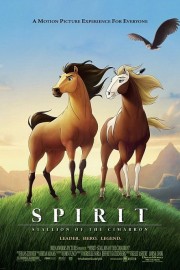Spirit: Stallion of the Cimarron
It’s been 12 years since I’d seen “Spirit: Stallion of the Cimarron,” and I’ll be honest, this is one time where I was really wondering whether my memories of how I felt would hold true. It’s not really considered one of Dreamworks’s best animated features, although I’ve felt so, and it was one of their last gasps at making a hand-drawn animated feature, with the next year’s “Sinbad: Legend of the Seven Seas” putting the final nail in the coffin for hand-drawn at Dreamworks Animation. Would it hold up to 12 years of gained life experience and film criticism, or would it feel like the bore most people pegged it for at the time?
First of all, let’s look at the film for what it is: a fascinating narrative experiment. For one thing, it’s a western, and let’s be honest, those have waned in popularity over the years. For another thing, it’s the story of a stallion named Spirit, but this film doesn’t follow the typical animated formula of giving the animals human voices, although they do have anthropomorphized expressions. Instead, Spirit’s story is told through narration by Matt Damon (meant to represent the heart of the stallion), and his emotions reflected in the songs of Bryan Adams, arranged by Hans Zimmer and co. to work with the Oscar-winning composer’s adventurous score. With Damon and Adams giving voice to Spirit in a way expressions can’t always do, the film follows the stallion from birth through a journey that finds him becoming the leader of his heard; then captured by an army cavalry, with the colonel (voiced by James Cromwell) intent on breaking him; and then freed by a Lakota Indian named Little Creek (Daniel Studi), under whose care he meets a mare named Rain whom he falls in love with.
Now, let’s look at the film for what it isn’t: it’s not quite the great film I saw in 2002. I think at the time I responded more to the animation, the music, and the Cimarron setting, since it’s in Cimarron, New Mexico where the Philmont Scout Ranch I went to in 1993 and 1995 is located. Just because it’s not quite the caliber of film I remember, however, that doesn’t mean it isn’t a fine film by any means. The screenplay by John Fusco takes chances some kids movies just don’t nowadays (and also gives us a look at westward expansion we don’t really see much anymore), and the direction by Kelly Asbury and Lorna Cook (who had previously been art directors on “The Prince of Egypt”) is a wonderful blend of hand-drawn and CG elements that leads to some truly beautiful images. At 83 minutes, the film doesn’t waste time narratively, which is important since so much of the story is told through the perspective of Spirit and the other horses in the cast. On the musical front, Zimmer’s score is pitch-perfect for the film, and his arrangements aide in bringing Adams’s songs to life, although those songs (with the exception of “Here I Am”) aren’t quite of the classic variety he dealt with on “The Lion King” or “The Prince of Egypt.”
Whatever issues the film has, though, don’t detract enough from it being fine adventure film for young and old alike, along with a type of storytelling challenge few filmmakers really seem to be up for nowadays. Watching “Spirit” again, I can see the seeds being planted for something like the “How to Train Your Dragon” franchise, which also rises and falls on the personality of an animal (or race of them, in “Dragon’s” case) whose communication with the human characters comes from looks and animal noises rather than giving them human voices. In the end, “Spirit” doesn’t soar to that series’s emotional and artistic heights, but rising to the level it does is more than enough for this moviegoer.










